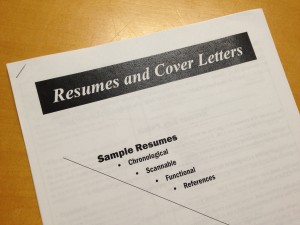 Imagine you’re an employer hiring for an entry-level opening at a large company. Your Human Resources office just sent you an e-mail with more than 200 resumes attached and you need to review them to select some qualified candidates to interview. At first it seems exciting—200 resumes! Surely somebody great will be in the mix.
Imagine you’re an employer hiring for an entry-level opening at a large company. Your Human Resources office just sent you an e-mail with more than 200 resumes attached and you need to review them to select some qualified candidates to interview. At first it seems exciting—200 resumes! Surely somebody great will be in the mix.
After an hour of scrolling through resumes on your lunch break, your enthusiasm dwindles. Isn’t anybody qualified? The requirements for the job were pretty clear: college degree, customer service experience, specific technical skills. And yet, none of the applicants you’ve reviewed look like they’ve even read the job description! You have a few that you’ve printed out for further scrutiny, but even those aren’t thrilling. One applicant looks like a candidate, but they used a different job title in the cover letter, and you’re not sure if they’re even interested in the position with your department. As you finish up the initial review you are grumpy, irritable, and nervous about finding a good fit for the position.
Now, imagine you’re the job-seeker in this scenario. How could you stand out among those 200 applicants when you only have a few seconds of the employer’s time?
Show clear interest in the position: In the first paragraph of a cover letter make it clear what you are applying for and make sure the position matches! When you’re sending out lots of applications for similar positions it’s easy to forget to change the organization and title if you’re just recycling an old letter.
To really stand out, craft a new letter each time that addresses what the organization needs, not just what you have to offer. This doesn’t mean you have to start from scratch, but significant effort should be made to highlight the different pieces of your experience and skills the employer is seeking. Also, if you’re using an objective on your resume you have another opportunity to make the position you’re seeking crystal clear.
Tailor your materials to the job description: Take a highlighter to the job description and focus in on the required qualifications. The order in which the qualifications are listed gives you a clue to their relative importance. Was a college degree the first thing? Then you’ll want to be sure your education is prominent and displayed effectively. Was there a qualification listed that you don’t have? If it was a “preferred” or “desired” qualification, don’t worry about it, but if it was a major requirement for the job you should reconsider whether you’re truly a good fit for the role.
Next, choose the experiences you feature wisely. If everything you’ve done in the past four years connects to the position, go ahead and list it all in reverse chronological order. If not everything fits, selectively include only the relevant pieces and name the category accordingly. For most that means calling the section “Relevant” or “Related” experience, but it can be more specific if you want to draw attention to your directly-related industry experience (i.e. “Culinary Experience” or “Customer Service Experience”). Anything else you want to include that doesn’t relate can become “Additional” or “Other” experience and be listed without description. The CES resume packet has several examples.
Describe your experience well. Start with the action verb to describe tasks you’ve done that demonstrate skills you need for the position you are applying for. Include enough detail to provide context or show the scale and scope of your role. Compare the following examples:
- Organized events
- Organized multiple fundraising dinners that drew more than 500 participants per event
The second example makes it easier for the employer to visualize the work you’ve done and this statement gives you a stepping off point to describe the pieces that went into the events you organized. Notice that example #2 isn’t particularly long–you can include details while still being concise.
Make it easy: Your materials should clearly indicate that you know what the employer is looking for and you’ve done your best to showcase how your background fits their needs.
CES advisors can provide guidance and objective feedback to help you make the best impression. Schedule an appointment or come in for drop-in advising (M-F from 2-4 p.m.). You don’t have to do it alone!
© 2011 Career and Employment Services, University of Puget Sound
Photo: Kris Hay